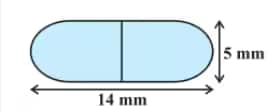NCERT Solutions for Class 10 Maths Chapter 12 Surface Areas and Volumes
CBSE Class 10th Exam Date:01 Jan' 26 - 14 Feb' 26
Imagine you're designing a water tank for your home. You need to calculate how much water it can hold (volume) and how much material will be needed to paint the outside of this water tank(surface area). The answer to these questions lies in understanding surface areas and volumes. This chapter helps us to understand how to calculate the area related to covering a solid object and the space it occupies. It also deals with calculating the surface area and volume of different solids like cubes, cylinders, cones, and spheres, and the formulas for surface area and volume. NCERT Solutions for Class 10 can help the students understand these concepts and will make them more efficient in solving problems involving Surface Areas and Volumes.
This Story also Contains
- NCERT Solutions for Class 10 Maths Chapter 12 Surface Areas and Volumes: Download Free PDF
- NCERT Solutions for Class 10 Maths Chapter 12 Surface Areas and Volumes (Exercise)
- Surface Areas and Volumes Class 10 NCERT Solutions: Exercise-wise
- Class 10 Maths NCERT Chapter 12: Extra Question
- Surface Areas And Volumes Class 10 Solutions: Important Formulae
- Surface Areas and Volumes Class 10 Chapter 12: Topics
- Why are Class 10 Maths Chapter 12 Surface Areas and Volumes question answers important?
- NCERT Solutions for Class 10 Maths: Chapter Wise
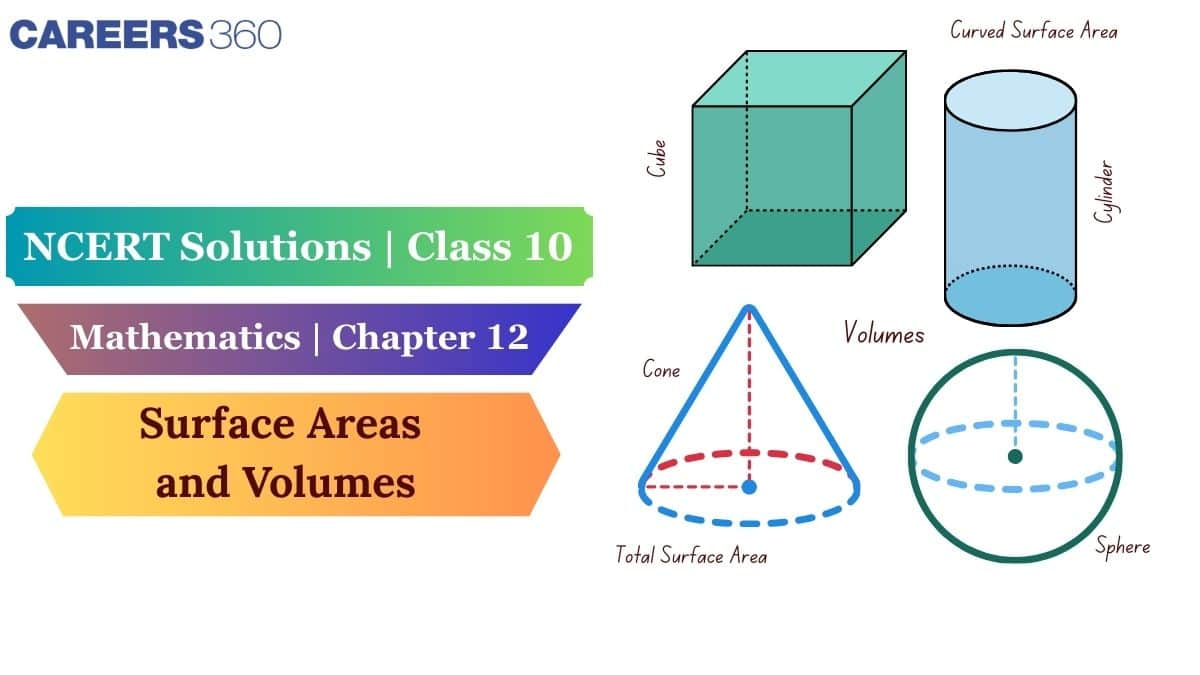
These NCERT Solutions for class 10 Maths are designed by our experienced subject matter experts to offer a structured approach and step-by-step solutions for students to prepare for the board exams. These Solutions cover all exercises in the NCERT textbook and are easily available for download. The step-by-step explanations for different types of problems help students gain a strong understanding of surface area and volume. Many toppers rely on NCERT Solutions since they are designed as per the latest syllabus. Find everything in one place – NCERT Books, Solutions, Syllabus, and Exemplar Problems with Solutions – in this NCERT article.
NCERT Solutions for Class 10 Maths Chapter 12 Surface Areas and Volumes: Download Free PDF
The NCERT Solutions for Class 10 Maths Chapter 12 have been prepared by Careers360 experts to make learning simpler and to help you score better in exams. A downloadable PDF is available — click the link below to access it.
NCERT Solutions for Class 10 Maths Chapter 12 Surface Areas and Volumes (Exercise)
NCERT Class 10 Maths Chapter 12 Surface Areas and Volumes question answers with detailed explanations are provided below.
| Surface Areas and Volumes Class 10 Question Answers Exercise: 12.1 Page number: 166-167 Total questions: 9 |
Q1. 2 cubes each of volume 64 cm3 are joined end to end. Find the surface area of the resulting cuboid.
Answer:
We are given that the volume of the cube $=\ 64\ cm^3$
Also, the volume of a cube is given by $=\ a^3$ ( here $a$ is the edge of the cube)
Thus : $a^3\ =\ 64$
$a\ =\ 4\ cm$
Now, according to the question, we have combined the two cubes.
The edge lengths of the formed cuboid are 4 cm, 4 cm, and 8 cm.
The surface area of a cuboid is : $=\ 2\left ( lb\ +\ bh\ +\ hl \right )$
$=\ 2\left ( 8\times 4\ +4\times 4\ +\ 4\times 8 \right )$
$=\ 2\left ( 80 \right )$
$=\ 160\ cm^2$
Thus, the area of the formed cuboid is 160 cm2.
Answer:
Since the vessel consists of a hemisphere and a cylinder, its area is given by :
Area of vessel = Inner area of the cylinder(curved) + Inner area of the hemisphere
The inner surface area of the hemisphere $=\ 2\pi r^2$
$=\ 2\times \left ( \frac{22}{7} \right ) \times 7^2$
$=\ 308\ cm^2$
The surface area of the cylinder $=\ 2\pi rh$
$=\ 2\times \frac{22}{7}\times 7\times 6$
$=\ 264\ cm^2$
Thus, the inner surface area of the vessel is $= 308 + 264 = 572 \:cm^2.$
Answer:
The required surface area of the toy is given by :
Area of the toy = Surface area of the hemisphere + Surface area of the cone
Firstly, consider the hemisphere :
The surface area of a hemisphere $=\ 2 \pi r^2$
$=\ 2 \times \frac{22}{7}\times \left ( 3.5 \right )^2$
$=\ 77\ cm^2$
Now for cone, we have :
The surface area of a cone $=\ \pi rl$
Thus, we need to calculate the slant of the cone.
We know that :
$l^2\ =\ h^2\ +\ r^2$
$=\ 12^2\ +\ 3.5^2$
$=\ \frac{625}{4}$
$l\ =\ \frac{25}{2}\ =\ 12.5\ cm$
Thus, the surface area of a cone $=\ \pi rl$
$=\ \frac{22}{7}\times 3.5\times 12.5$
$=\ 137.5\ cm^2$
Hence, the total surface area of the toy $=\ 77\ +\ 137.5\ =\ 214.5\ cm^2.$
Answer:
It is given that the hemisphere is mounted on the cuboid; thus, the hemisphere can take on complete as its diameter (which is maximum).
Thus, the greatest diameter of the hemisphere is 7 cm.
Now, the total surface area of the solid = Surface area of the cube + Surface area of the hemisphere - Area of the base of a hemisphere (as this is counted on one side of the cube)
The surface area of the cube $=\ 6a^3$
$=\ 6\times 7^3\ =\ 294\ cm^2$
Now, the area of a hemisphere $=\ 2\pi r^2$
$=\ 2\times \frac{22}{7}\times \left ( \frac{7}{2} \right )^2\ =\ 77\ cm^2$
The area of the base of a hemisphere $=\ \pi r^2\ =\ \frac{22}{7}\times \left ( \frac{7}{2} \right )^2\ =\ 38.5\ cm^2$
Hence, the surface area of the solid is $= 294 + 77 - 38.5 = 332.5 \:cm^2$.
Answer:
It is given that the diameter of the hemisphere is equal to the edge length of the cube.
The total surface area of the solid is given by :
The surface area of a solid = Surface area of the cube + Surface area of the hemisphere - Area of the base of the hemisphere
The surface area of the cube $=\ 6l^2$
The surface area of the hemisphere:
$=\ 2\pi r^2\ =\ 2\pi \left ( \frac{l}{2} \right )^2$
Area of the base of the hemisphere:
$=\ \pi r^2\ =\ \pi \left ( \frac{l}{2} \right )^2$
Thus, the area of the solid is:
$=\ 6l^2\ +\ \pi \left ( \frac{l}{2} \right )^2\ unit^2.$
Answer:
It is clear from the figure that the capsule has a hemisphere and cylinder structure.
The surface area of the capsule = 2 (Area of the hemisphere) + Area of the cylindrical part
Area of hemisphere $=\ 2\pi r^2$
$=\ 2\pi\times \left ( \frac{5}{2} \right )^2$
$=\ \frac{25}{2} \pi\ mm^2$
The area of the cylinder $=\ 2\pi rh$
$=\ 2\pi \times \frac{5}{2}\times 9$
$=\ 45 \pi\ mm^2$
Thus, the area of the solid $=\ 2\left ( \frac{25}{2} \right )\pi\ +\ 45 \pi$
$=\ 25\pi\ +\ 45 \pi$
$=\ 70 \pi$
$=\ 220\ mm^2.$
Answer:
The canvas will cover the cylindrical part as well as the conical part.
So, the area of the canvas = Area of the cylindrical part (curved) + Area of the conical part
Now, the area of the cylindrical part $=\ 2\pi rh$
$=\ 2\pi \times 2\times 2.1$
$=\ 8.4 \pi\ m^2$
The area of the cone is $=\ \pi rl$
$=\ \pi \times 2\times 2.8$
$=\ 5.6\pi\ m^2$
Thus, the area of the canvas $=\ 8.4\pi\ +\ 5.6\pi$
$=\ 14\pi\ =\ 44\ m^2$
Further, it is given that the rate of canvas per m2 is Rs. 500.
Thus, the required money is $=500 \times 44=$ Rs. 22,000.
Answer:
Firstly, we need to calculate the slant height of the cone :
$l^2\ =\ r^2\ +\ h^2$
$⇒l^2=\ (0.7)^2\ +\ (2.4)^2$
$⇒l^2\ =\ 6.25$
$⇒l\ =\ 2.5\ cm$
Now, the total surface area of a solid can be calculated as :
The surface area of the solid = Surface area of the cylinder + Surface area of the cone + Area of the base of the cylinder
The surface area of the cylinder is $=\ 2 \pi rh$
$=\ 2 \pi \times 0.7\times 2.4$
$=\ 10.56\ cm^2$
Now, the surface area of a cone $=\ \pi rl$
$=\ \pi \times 0.7\times 2.5$
$=\ 5.50\ cm^2$
And the area of the base of the cylinder is $=\ \pi r^2$
$=\ \pi \times 0.7\times 0.7$
$=\ 1.54\ cm^2$
Thus, the required area of the solid = 10. 56 + 5.50 + 1.54 = 17.60 cm2.
Thus, the total surface area of the remaining solid to the nearest cm2 is 18 cm2.
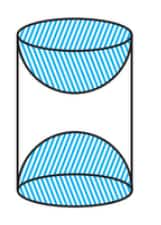
Answer:
The required surface area is given by :
The surface area of the article = Surface area of the cylindrical part + 2 (Surface area of the hemisphere)
Now, the area of the cylinder $=\ 2\pi rh$
$=\ 2\pi \times 3.5\times 10$
$=\ 70\pi \ cm^2$
The surface area of the hemisphere $=\ 2\pi r^2$
$=\ 2\pi \times 3.5\times 3.5$
$=\ 24.5\pi\ cm^2$
Thus the required area $=70 \pi +2\times 24.5 \pi = 374 cm^2.$
| Surface Areas and Volumes Class 10 Question Answers Exercise: 12.2 Page number: 169-170 Total questions: 8 |
Answer:
The volume of the solid is given by :
The volume of the solid = Volume of the cone + Volume of a hemisphere
The volume of the cone $=\ \frac{1}{3} \pi r^2h$
$=\ \frac{1}{3} \pi \times 1^2\times 1$
$=\ \frac{\pi}{3}\ cm^3$
The volume of the hemisphere $=\ \frac{2}{3}\pi r^3$
$=\ \frac{2}{3}\pi \times 1^3$
$=\ \frac{2\pi}{3}\ cm^3$
Hence, the volume of so lithe d is :
$=\ \frac{\pi}{3}\ +\ \frac{2\pi}{3}\ =\ \pi\ cm^3.$
Answer:
The volume of air present = Volume of cylinder + 2 (Volume of a cone)
Now, the volume of a cylinder: $=\ \pi r^2h$
$=\ \pi \left ( \frac{3}{2} \right )^2\times 8$
$=\ 18\pi \ cm^3$
The volume of a cone is $=\ \frac{1}{3} \pi r^2h$
$=\ \frac{1}{3} \pi \times \left ( \frac{3}{2} \right )^2\times 2$
$=\ \frac{3}{2} \pi \ cm^3$
Thus, the volume of air is $=\ 18 \pi\ +\ 2\times \frac{3}{2} \pi \ =\ 21\pi$
$=\ 66\ cm^3$
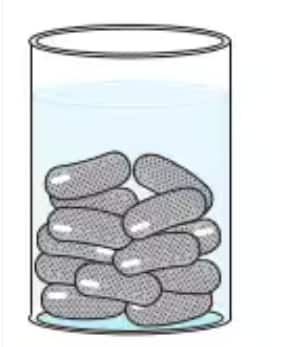
Answer:
It is clear from the figure that Gulab Jamun has one cylindrical part and two hemispherical parts.
Thus, the volume of the gulab jamun is = Volume of cylindrical part + 2 (Volume of the hemisphere )
Now, the volume of the cylinder is $=\ \pi r^2h$
$=\ \pi\times 1.4^2\times 2.2$
$=\ 13.55\ cm^3$
The volume of a hemisphere is :
$\\=\ \frac{2}{3}\pi r^3\\\\=\ \frac{2}{3}\times \pi \times (1.4)^3\\\\=\ 5.75\ cm^3$
Thus, the volume of 1 gulab jamun is $= 13.55 + 2 (5.75) = 25.05 cm^3.$
Hence, the volume of 45 gulab jamun $=\ 45(25.05)\ cm^3\ =\ 1127.25\ cm^3$
Further, it is given that one gulab jamun contains sugar syrup up to 30%.
So, the total volume of sugar present $=\ \frac{30}{100}\times 1127.25\ =\ 338\ cm^3.$
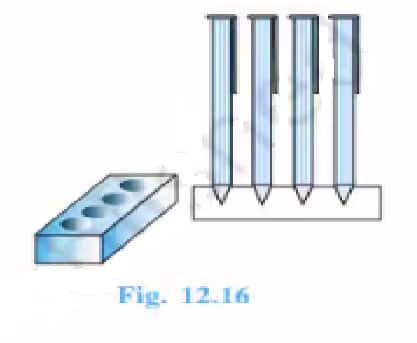
Answer:
The volume of wood is given by = volume of the cuboid - the volume of four cones.
Firstly, the volume of the cuboid $=\ lbh$
$=\ 15\times 10\times 3.5$
$=\ 525\ cm^3$
And the volume of the cone
$=\frac13 \pi r^2h=\frac13 \pi \times 0.5^2 \times 1.4= 0.3665 \ cm^3$
Thus, the volume of wood is $= 525 - 4 (0.3665) = 523.53 \:cm^3.$
Answer:
According to the question :
Water spilt from the container = Volume of lead balls.
Let us assume the number of lead balls to be n.
Thus, the equation becomes :
$\frac{1}{4}\times Volume_{cone}\ =\ n\times \frac{4}{3} \pi r^3$
$⇒\frac{1}{4}\times \frac{1}{3}\pi\times5^2\times 8\ =\ n\times \frac{4}{3} \pi\times 0.5^3$
$⇒n\ =\ \frac{25\times 8}{16\times \left ( \frac{1}{2} \right )^3}$
$⇒n\ =\ 100$
Hence, the number of lead shots dropped is 100.
Answer:
The pole can be divided into one large cylinder and one small cylinder.
Thus, the volume of the pole = volume of a large cylinder + volume of a small cylinder
$=\ \pi r_l^2h_l\ +\ \pi r_s^2h_s$
$=\ \pi \times 12^2\times 220\ +\ \pi \times 8^2\times 60$
$=\ \pi \times \left ( 144\times 220\ +\ 64\times 60 \right )$
$=\ 3.14\times 35520$
$=\ 111532.5\ cm^3$
Now, according to the question, the mass of the pole is :
$=\ 8\times 111532.5$
$=\ 892262.4\ g\ =\ 892.262\ Kg.$
Answer:
It is clear from the question that the required volume is :
The volume of water (left) =Volume of a cylinder - Volume of a solid
Now the volume of the cylinder is
$=\ \pi r^2h$
$=\ \pi\times (60)^2\times 180\ cm^3$
The volume of the solid is :
$\\=\ \frac{1}{3} \pi r^2h\ +\ \frac{2}{3}\pi r^3$
$=\ \frac{1}{3} \times \pi \times (60)^2\times 120\ +\ \frac{2}{3}\times \pi \times (60)^3$
$=\ \pi (60)^2\times 80\ cm^3$
Thus, the volume of water left :
$\\=\ \pi (60)^2\times 180\ -\ \pi (60)^2\times 80$
$=\ \pi (60)^2\times 100$
$=\ 1131428.57\ cm^3\\\\=\ 1.131\ m^3.$
Answer:
The volume of the vessel is given by :
The volume of the vessel = Volume of the sphere + Volume of the cylindrical part
Now, the volume of the sphere is :
$\\=\ \frac{4}{3}\pi r^3$
$=\ \frac{4}{3}\pi \left ( \frac{8.5}{2} \right )^3$
$=\ 321.55\ cm^3$
The volume of the cylinder is:-
$\\=\ \pi r^2h\\\\=\ \pi \times (1)^2\times 8\\\\=\ 25.13\ cm^3$
Thus, the volume of the vessel is $= 321.55 + 25.13 = 346.68\: cm^3.$
Surface Areas and Volumes Class 10 NCERT Solutions: Exercise-wise
Exercise-wise NCERT Solutions of Surface Areas and Volumes Class 10 Maths Chapter 12 are provided in the links below.
Class 10 Maths NCERT Chapter 12: Extra Question
Question:
A cylinder of height 8 cm and radius 6 cm is melted and converted into three cones of the same radius and height as the cylinder. Determine the total curved surface area of cones.
Answer:
The radius ($r$) of each cone = radius of the cylinder = 6 cm
The height ($h$) of each cone = height of the cylinder = 8 cm
The curved surface area of a cone, where $l$ is the slant height of the cone $= \pi r l$
Now, $l = \sqrt{r^2 + h^2}= \sqrt{(6)^2 + (8)^2} = 10 \text{ cm}$
The curved surface area of a cone, where $l$ is the slant height of the cone $= \pi r l$
So, the curved surface area of each cone,
$= \pi (6) (10) = 60\pi \text{ cm}^2$
Since there are 3 cones, the total curved surface area,
$= 3 \times 60\pi = 180\pi \text{ cm}^2$
Hence, the correct answer is $180\pi \text{ cm}^2$.
Surface Areas And Volumes Class 10 Solutions: Important Formulae
Total Surface Area (TSA)
Total Surface Area, denoted as TSA, signifies the entire expanse covered by an object's surface. This encompasses the collective area of all its external facets. Here are some prominent geometrical figures and their corresponding TSA formulas.
- Cuboid: TSA = 2[(l x b) + (b x h) + (h x l)], { where, l = length, b = breadth, h = height }.

- Cube: TSA = 6a2 , { where, a = length of the sides of a square }
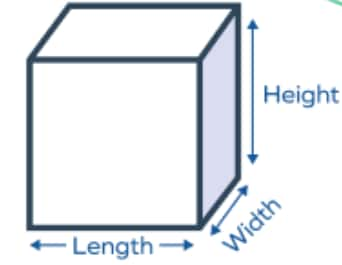
- Right Circular Cylinder: TSA = 2πr(h + r), { where, h = height of the cylinder, r = radius of the circular part }
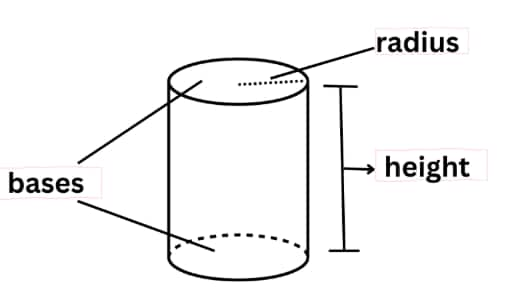
- Right Circular Cone: TSA = πr(l + r), { where, l = Slant height of the cone, r = radius of the circular part }
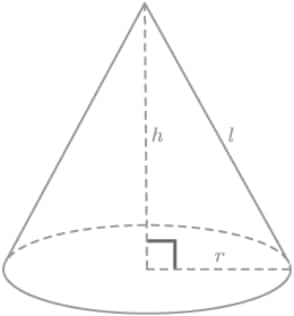
- Sphere: TSA = 4πr2 , { where, r = radius of the sphere }
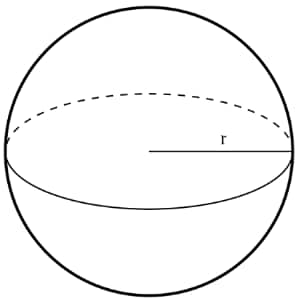
- Right Pyramid: TSA = LSA (Lateral Surface Area) + Area of the base
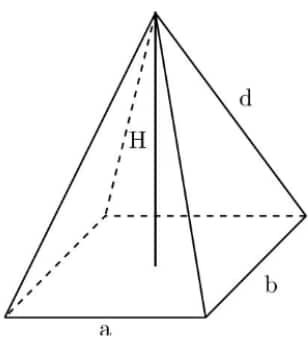
- Prism: TSA = LSA (Lateral Surface Area) × 2B (Area of the base)
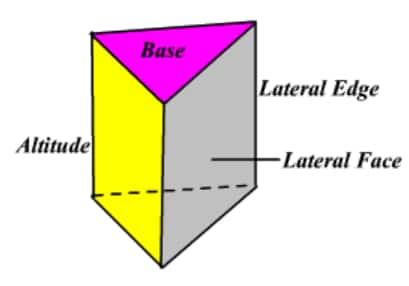
- Hemisphere: TSA = 3 × π × r2 , { where, r = radius of the circular part }
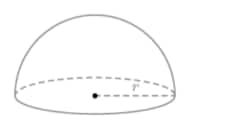
Lateral/Curved Surface Area (LSA/CSA)
The concept of Curved Surface Area (CSA) or Lateral Surface Area (LSA) comes into focus, particularly in forms such as cylinders, cones, and pyramids. CSA represents the area of the curved component or sides, excluding the top and bottom facets. LSA, on the other hand, pertains to the lateral area of various shapes. The following are some key examples of these surface area measures:
- Cuboid: CSA = 2h(l + b), { where, l = length, b = breadth, h = height }.
- Cube: CSA = 4a2 , { where, a = length of the sides of a square }
- Right Circular Cylinder: CSA = 2πrh, { where, h = height of the cylinder, r = radius of the circular part }
- Right Circular Cone: CSA = πrl, { where, l = Slant height of the cone, r = radius of the circular part }
- Right Pyramid: LSA = $\frac12$× p × d, { where, p = base perimeter, d = slant height}
- Prism: LSA = p × h, { where, p = base perimeter, h = height}
- Hemisphere: LSA = 2 × π × r2, { where, r = radius of the circular part }
Volume
Volume emerges as a fundamental attribute, denoting the spatial extent occupied by an object or substance, quantified in cubic units. The following volume formulas unravel the essence of these geometric measurements:
- Cuboid: Volume = lbh, { where, l = length, b = breadth, h = height }
- Cube: Volume = a3, { where, a = length of the sides of a square }
- Right Circular Cylinder: Volume = πr2h, { where, h = height of the cylinder, r = radius of the circular part}
- Right Circular Cone: Volume = $\frac13$πr2h, { where, h = height of the cylinder, r = radius of the circular part }
- Sphere: Volume = $\frac43$πr3, { where, r = radius of the sphere }
- Right Pyramid: Volume = $\frac13$ × Area of the base × h, { where, h = height }
- Prism: Volume = B (Area of the base) × h, { where, h = height }
- Hemisphere: Volume = $\frac23$× (πr3), { where, r = radius of the sphere
Surface Areas and Volumes Class 10 Chapter 12: Topics
Topics you will learn in NCERT Class 10 Maths Chapter 12 Surface Areas and Volumes include:
- 12.1 Introduction
- 12.2 Surface Area of a Combination of Solids
- 12.3 Volume of a Combination of Solids
Why are Class 10 Maths Chapter 12 Surface Areas and Volumes question answers important?
This chapter helps you learn how to find the surface area and volume of different 3D shapes and their combinations. It connects the shapes we see in real life with mathematical formulas. These Class 10 Maths Chapter 12 Surface Areas and Volumes question answers help us understand and apply these formulas easily. Here are some more points on why these question answers are important:
- These solutions help us calculate surface areas and volumes of combined solids such as cones, cylinders, and spheres.
- These question answers make solving real-life problems involving tanks, pipes, and boxes much easier.
- These Class 10 Maths Chapter 12 Surface Areas and Volumes question answers prepare us for higher classes where 3D geometry and mensuration are studied in more depth.
NCERT Solutions for Class 10 Maths: Chapter Wise
Access all NCERT Class 10 Maths solutions from one place using the links below.
Also, read,
- NCERT Exemplar Class 10 Maths Solutions Surface Areas and Volumes
- NCERT Notes Class 10 Maths Surface Areas and Volumes
NCERT Exemplar Solutions - Subject Wise
Given below are the subject-wise exemplar solutions of class 10 NCERT:
NCERT Books and NCERT Syllabus
Here are some useful links for NCERT books and the NCERT syllabus for class 10:
Frequently Asked Questions (FAQs)
Surface Areas and Volumes is a high-scoring chapter in board exams. Many application-based and word problems are asked in exams from this chapter, making it crucial for both conceptual understanding and practical use.
The concepts of surface areas and volumes are applied widely in real life. In construction, architects and engineers use these principles to calculate the amount of material needed for building structures, such as the walls or roofs of buildings. In the packaging industry, companies use surface area formulas to design packaging materials that minimise waste while ensuring the container fits the product properly.
To find the surface area of a combination of solids, we require breaking the complex solid into simpler shapes. Like, if we have a cone placed on top of a hemisphere, we first calculate the surface area of the cone(excluding its base) and then calculate the surface area of the hemisphere. Once we have the surface areas of the individual solids, we can simply add them together to find the total surface area. We have to carefully exclude any overlapping areas, like the base of the cone that touches the hemisphere, to avoid double-counting.
Important formulas for this chapter are:
Surface Area and Volume of Sphere, Hemisphere, Cone, Cylinder, and Frustum.
A combination of solids (like a cone on a cylinder).
In board exams, questions from Chapter 12 typically focus on calculating the surface area and volume of solids. These can include both direct calculation problems, where you simply apply the formulas, and more complex word problems that involve real-life situations, such as finding the amount of material needed to cover a tank or determining the volume of water a container can hold. There may also be questions involving the combination of solids, where you need to calculate the surface area or volume of an object made up of more than one solid. These questions test both your conceptual understanding and problem-solving skills.
Questions related to CBSE Class 10th
On Question asked by student community
The CBSE Sahodaya Question Papers for Class 10 (2025-26) are not released centrally by the board as a single PDF.
Here is the essential information you need:
-
Local Release: The papers are designed and released by the individual Sahodaya School Clusters (groups of CBSE schools) just before or during the pre-board exam dates (typically held in December and January). Therefore, you must check your local cluster's portal or directly with your school administration.
-
Best Practice: The official model papers, based on the full 2026 syllabus, are the most reliable tool for practice. These accurately reflect the structure, format, and competency-based questions used in the Sahodaya exams.
You can download the latest CBSE Class 10 Model Papers to simulate the Sahodaya tests here: https://school.careers360.com/articles/sahodaya-question-paper-2025 . Focus on that pattern
Hi! If you’re looking for the Class 11 English half yearly question paper for 2025-26 (CBSE board), you’ll find the right resource once you check the link provided from Careers360. Solving previous or sample papers is a smart way to prepare, as it helps you understand the question types, marking scheme, and important topics. This practice will boost your confidence and help you manage your time well in the actual exam.
https://school.careers360.com/boards/cbse/cbse-class-11-half-yearly-sample-papers-2025-26
Hi dear candidate,
Could you please specify us the board of education for which you need the half yearly question papers of class X so that we can help you further.
Below are few links which may help you and it has all the subjects with English as well:
CBSE Class 10 Half Yearly Exam Question Paper 2025-26 with Answer Key & Analysis
ICSE Class 10 Half Yearly Sample Papers 2025-26 PDF (All Subjects)
BEST REGARDS
Hi dear candidate,
Can you please specify the board of education or state for which you need to know the exam pattern and syllabus so that we can guide you accordingly.
Since, most of the boards uses NCERT as base syllabus, you can refer to the link below:
NCERT Syllabus for Class 10 – All Subjects PDF Download 2025-26
Exam pattern:
CBSE 10th New Exam Pattern 2026- Marking Scheme, Subject-Wise Exam Pattern
BEST REGARDS
The CBSE Class 10th Board Exams for the 2026 session will follow the revised curriculum, emphasizing competency-based questions.
-
Conducting Body: Central Board of Secondary Education (CBSE).
-
Exam Period: The main theory exams are typically held between February and April 2026.
-
Grading: Based on marks in five main subjects plus internal assessment marks (often 20 marks per subject) provided by the school.
-
Passing Criteria: You must achieve at least 33% overall in each subject (theory + practical/internal assessment combined) to be declared pass.
Key Preparation Strategy
The most crucial element of your preparation is understanding the exam structure:
-
Syllabus: Strictly adhere to the rationalized syllabus released by CBSE for the 2025-26 academic year.
-
Practice: Your primary resource should be the latest sample papers and previous year question papers. These accurately reflect the format and types of competency questions being asked.
For the most comprehensive and official announcements, including the detailed time table and access to crucial practice materials, always check the official board updates, as tracked by Careers360: https://school.careers360.com/exams/cbse-class-10th .
Applications for Admissions are open.
As per latest syllabus. Physics formulas, equations, & laws of class 11 & 12th chapters
JEE Main Important Chemistry formulas
Get nowAs per latest syllabus. Chemistry formulas, equations, & laws of class 11 & 12th chapters
JEE Main high scoring chapters and topics
Get nowAs per latest 2024 syllabus. Study 40% syllabus and score upto 100% marks in JEE
JEE Main Important Mathematics Formulas
Get nowAs per latest syllabus. Maths formulas, equations, & theorems of class 11 & 12th chapters
